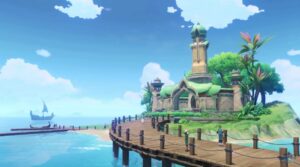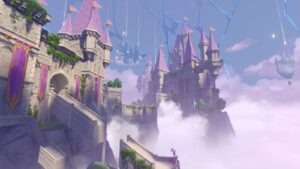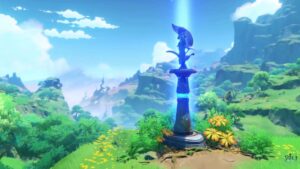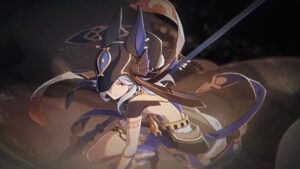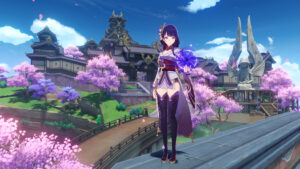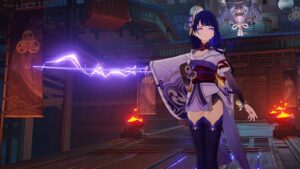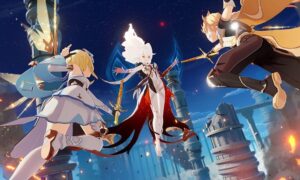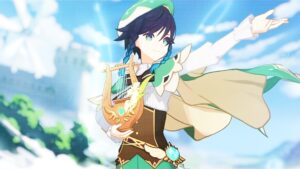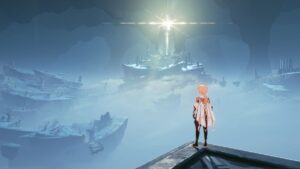SPOILERS FOR GENSHIN IMPACT VERSION 3.0 AND 3.1 AHEAD!
If you play Genshin Impact and are active on Twitter, chances are you had already come across the leaked character models of nearly every upcoming character from Version 3.0 through at least Version 3.4, long before HoYoverse gave in and officially revealed most of them in a recent teaser trailer for the upcoming region of Sumeru. The Sumeru character leaks have been (and continue to be) unavoidable – everywhere you turn, there’s fan-art of the most popular characters, redesigns of the characters that fans wish were more culturally and historically accurate (most if not all of them, if we’re being honest), and out-of-context screenshots from the ongoing 3.0 beta of the characters and NPCs we’ll be meeting straightaway when we enter Sumeru near the end of August.
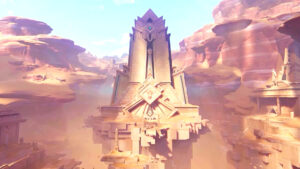
The teaser trailer lays the groundwork for the Sumeru Archon Quest, which is expected to be larger in scope and potentially much longer than the controversial Inazuma Archon Quest. The six characters highlighted in this new trailer, those being Al-Haitham, Al-Tighnari, Cyno, Dehya, Nahida, and Nilou, are each rumored to play a significant role in the Sumeru Archon Quest (and that’s pretty much all I’ll say on that topic, because while this post is spoiler-tagged so we can talk about the characters themselves – primarily their kits and potential playstyles – I don’t want to completely ruin anyone’s enjoyment of the new Archon Quest by revealing story spoilers), but that’s not the only thing these characters have in common.
While there was initially some debate over Dehya’s rarity, leakers now unanimously agree that all six of these characters (including Dehya) belong to the five-star character class – the higher of the two character classes in Genshin Impact. Five-star characters, with their unique burst animations and high base stats, are generally considered stronger or more efficient than their four-star counterparts; therefore, most are only available on limited-time banners that rerun at random intervals, often coinciding with events in which said character plays a significant role. On the one hand, that makes them harder to obtain if you’re not willing to spend actual money on the Primogems you need to pull for characters – but on the other hand, it’s easier to guarantee a specific limited-time five-star for yourself than any specific four-star or even a Standard Banner five-star like Diluc or Jean.
Anyway, I could have told you that everyone in this trailer was a five-star based solely on the fact that Collei and Dori, two four-star characters rumored to be heavily involved in the Sumeru Archon Quest, don’t appear even briefly…the reason being that Collei and Dori, like all four-star characters, will be readily available on the permanent Standard Banner within a month of their first rate-up on Al-Tighnari’s banner – so no one will ever have any incentive to pay for them (and frankly, I wouldn’t pull for Dori even if HoYoverse was paying me, much less spend money on her).
Speaking of Al-Tighnari’s banner, there’s an interesting and surprisingly credible rumor going around that the on-field DPS Dendro bow-user will become the first new five-star to be placed on the permanent Standard Banner since Genshin Impact‘s launch, which is the kind of information that could either negatively affect his banner sales (especially if he’s one of the weaker five-stars, as Standard Banner five-stars tend to be) or potentially boost them (if fans of the character collectively jump at the chance to obtain Tighnari before he ironically becomes harder to obtain amongst a bunch of other five-star units).
Me, I’m saving all my Primogems for Cyno and Dehya, the only two playable characters in Sumeru (at least that we’ve seen) whose skin isn’t literally paper-white, making them by default the darkest-skinned five-star characters in Genshin Impact…although neither character’s skin is actually dark, mind you. In the real world, and almost certainly in the regions of South Asia and North Africa that inspired Sumeru, they’d be considered either light-skinned or white. In almost any other video game, including other gacha games by Chinese game developers like Dislyte, they’d be considered either light-skinned or white. Hell, even in Genshin Impact itself, when compared to brown-skinned four-star characters like Kaeya and Xinyan, and the unambiguously brown NPCs we’re starting to see throughout Sumeru, they’d be considered either light-skinned or white.
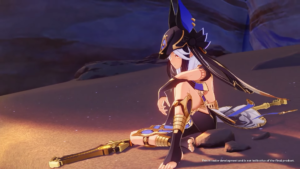
Some indignant players have cited the existence of Kaeya and Xinyan as indisputable evidence that the character designers at HoYoverse couldn’t possibly be guilty of perpetuating racism and colorism through their work, and in fact they’re actually progressive and ahead-of-the-curve, which is the type of excuse that I would maybe take seriously if Genshin Impact had, like, four playable characters at most…but as of this writing, that number is closer to fifty-four. And need I remind you that Kaeya and Xinyan are four-star characters, and thus nonsalable? The only reason these two characters and a couple of NPCs from Sumeru have brown skin is because they’re not made to sell, and if that ever changed for any reason, they’d be whitewashed.
That’s what this comes down to, ultimately. Genshin Impact‘s most desirable characters, its five-star characters, are intended to be desirable in every sense of the word (with the exception of Qiqi, a literal child), and their character designs almost inevitably conform to colorist notions of what is “desirable” because the beauty standards of China and Japan, HoYoverse’s two largest markets, are deeply rooted in colorism. HoYoverse didn’t create the problem, and they’re not the only corporation (nor even the only game studio) perpetuating it, but they also didn’t need to get themselves so deeply entangled in this mess and that’s what’s really frustrating about the whole situation.
Genshin Impact‘s fictional world of Teyvat is comprised of seven regions, and the three that have been released to date – Mondstadt, Liyue, and Inazuma – are inspired by late Medieval or early Renaissance-era Germany, Qing Dynasty China (well, to some extent), and Edo Period Japan, respectively. At those specific points in each country’s history, all three would have been predominantly ethnically homogeneous. Sumeru, however, isn’t based on just one country, but rather an amalgamation of something like thirteen different countries between Morocco in the west and India in the east – most of which are and have long been ethnically heterogeneous and racially diverse, by virtue of being situated at the junction of Africa, Asia, and Europe.
That’s why I have no sympathy for HoYoverse in this situation: because if you’re aware, as the game developers must have been after doing even the slightest bit of research into South Asian and North African people and their cultures, that you can’t ever commit to portraying these people and their cultures with even a modicum of respect, then you ought to either commit to the challenge and all of the responsibilities that come with it, or stop and think of a different story setting you can “borrow” from the real world that won’t have detrimental real-world consequences on the people whose cultures and history you’re “borrowing” if you mess up, as you inevitably will if you do what HoYoverse did, which is to stubbornly plow ahead without consideration for the consequences.
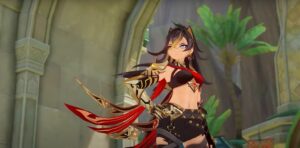
Even if you dismiss the lack of skintone diversity amongst the playable characters because “there are some pale or light-skinned people in South Asia and North Africa” (nobody’s saying there aren’t, by the way – we’re saying that it’s colorist for the playable characters from Sumeru to all be white or light-skinned, while the NPCs are tan or brown, but whatever), there’s still a stark difference between HoYoverse’s approach to the previous three regions and their current approach to Sumeru. For instance, the game developers very deliberately singled in on a specific time-period in Japanese history as the basis for Inazuma, to ensure that while they played around with more fantastical elements their focus remained clear and their vision remained cohesive. But with Sumeru, they’ve blenderized so many different cultures it’s impossible to tell which one is even the main ingredient in this dreadful concoction – which is spiked with a heavy dose of orientalism and exoticism for good measure.
That lack of focus behind-the-scenes is attested to in-game by Sumeru’s very own geography, which ranges from a humid rainforest on the borders of Liyue, to an arid desert in the far west where Sumeru butts up against the region of Natlan…with nothing in between but a few miles of sparsely-forested wasteland to ease that abrupt transition. We can see it again reflected in the whimsical architecture of Sumeru City, which bears little resemblance to anything in the real world, and in the fantastical flora and fauna of the rainforest area (the desert won’t be released until Version 3.1). And I’m sad to say it’s a recurring theme throughout the character designs – Al-Tighnari, Al-Haitham, Dehya, Nahida, and Nilou are Arabic/Amazigh/Persian in name only, and Cyno…isn’t even that.
Al-Tighnari, the first Dendro five-star in Genshin Impact, fittingly bears the name of an early 12th Century Arab agronomist and botanist…which makes it all the more upsetting that his design is unspeakably ugly and poorly-researched. He’s wearing a navy-blue hoodie (you can zoom in for yourself, it’s a literal hoodie) with mismatched sleeves because Genshin Impact‘s character designers are obsessed with asymmetry, navy-blue gloves (with rust-colored finger-pads, because why settle on just one hideous color when you can have the whole rainbow?), big rubbery-looking navy-blue bangles hanging off his arms, navy-blue lace-up boots, baggy navy-blue pants with red stripes down the sides, and a severe navy-blue bob hairdo with lime-green highlights. On top of all this, he has the ears and tail of a fennec fox…a navy-blue fennec fox, to be precise. I’ll be right back, I have to aggressively scrub my eyes with soap.
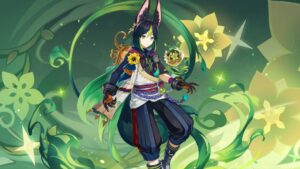
Ah, that’s better. Where were we? Oh yes, the next character on the list isn’t going to be playable until Version 3.4 or Version 3.5 at the earliest, but Twitter is already thirsting over Al-Haitham because he’s a tall and mysterious white man in a skin-tight, semi-transparent black bodysuit with one shoulder exposed (he has more muscle definition than Itto, I’ll begrudgingly give him that). Al-Haitham is rumored to be a Dendro sword user, although his release is still so far off that there haven’t been any leaks regarding the rest of his kit or potential playstyle. His design is sleek and futuristic, comprised of a lot of harsh angles and sharp lines; I don’t hate it, I just hate that it was probably chosen at the cost of the beautiful traditional clothing of any number of South Asian or North African cultures.
Cyno, whose name is derived from the Ancient Greek word for “dog”, kúōn, is an on-field main DPS Electro polearm user who lives in the desert area of Sumeru amidst the crumbling ruins of a civilization that once worshiped anthropomorphic gods similar to those of Ancient Egypt – including a jackal-headed deity whom Cyno emulates with his long-eared hat. I like the hat and its adorable ear-piercings, don’t know how I feel about the rest of Cyno’s outfit, which is relatively skimpy in comparison to most male characters in the game…it feels a bit like one of those ridiculous Halloween costumes for (white) adults that exoticize and fetishize Ancient Egyptian culture, but I’m hoping it’s not really that bad. We can’t see the entire outfit, to be fair.
I have similar concerns regarding Dehya, who is essentially wearing ripped jeans and a crop-top – not exactly what I would have picked out for a character who shares her name with a legendary 7th Century Amazigh queen, but maybe that’s just me. Nonetheless, Dehya is easily the best-dressed and most well-designed of the Sumeru five-stars (in my entirely unbiased opinion as an admirer of tall, muscular, claymore-wielding women), I just wish her design incorporated more…well, any elements of traditional Amazigh clothing. Between now and her estimated release date around Version 3.4 or Version 3.5, there’s still plenty of time to tweak her design slightly, HoYoverse (just please don’t lighten her skin any more, dear lord).
Nilou, described in the trailer as a dancer defying tradition, is rumored to be a sub-DPS or burst-DPS Hydro sword user releasing in Version 3.1, although we’ll meet her sooner than that during the Sumeru Archon Quest, as she’s presumably involved in the rapidly growing uprising against the Akademiya’s authoritarian rule of Sumeru. More research appears to have gone into her design than into certain other characters – Nilou even utilizes traditional Persian dance moves in her signature burst animation, and her outfit, ornate headdress, and tattoos are inspired by the costumes of Persian dancers from the time of the Sassanid Dynasty in what is now Iran. Unfortunately, her outfit has been sexualized to the point where she closer resembles orientalist stereotypes of belly dancers at first glance.
Finally, there’s Nahida – whose kit and playstyle haven’t leaked yet, although she’s currently rumored to be a Dendro catalyst-user releasing in Version 3.2, around the same time the Sumeru Archon Quest wraps up. Her outfit contains no discernible references to the traditional clothing of South Asia and North Africa, and honestly it’s a painfully average design on top of that; she’s wearing a simple, flower-shaped white dress with a couple of emerald-green accoutrements that clash terribly with her paper-white skin and hair. As fan-artists have been quick to demonstrate, Nahida really needed a brown skintone to complement the whites and greens in her clothing and hair if this was the route HoYoverse was insistent on taking with her design.
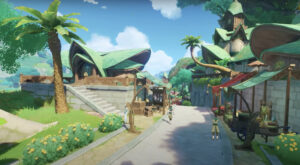
Well, that’s all of them. Unless there are a couple of four-star characters released in the near future whose designs really blow me away (I might pull for Collei, but I’ve already vowed never to use Dori even if I accidentally obtain her on the Standard Banner), I plan to save my Primogems for Cyno and Dehya…and yeah, that’s pretty much it. Sumeru and its five-star characters have disappointed me greatly – but my disappointment with HoYoverse is nothing compared to the hurt that South Asian, Southwest Asian, and North African fans have felt upon seeing some of these characters meant to represent them and their people, which is why I feel it’s important to actively call out the game developers and demand better…because it’s bad now, but it’s only going to get worse when the region of Natlan, inspired by pre-colonial South American and Mesoamerican cultures, comes out in Version 5.0, unless HoYoverse does something about it now.







